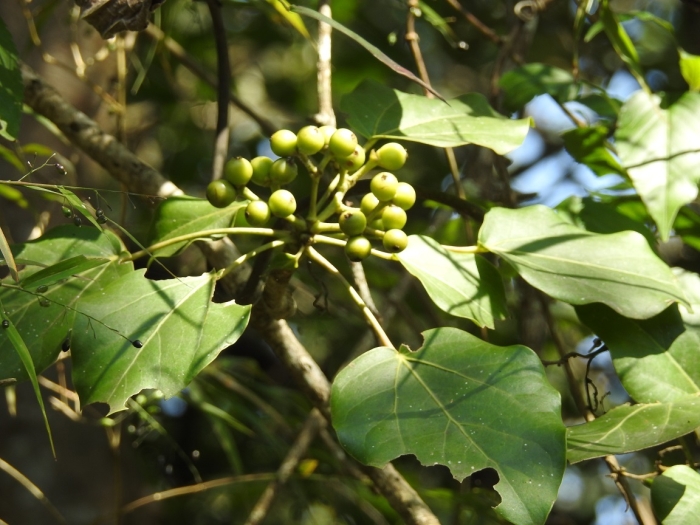Giant’s Hand Tree
(Oreopanax capitatus)
Giant’s Hand Tree (Oreopanax capitatus)
/
/

Neptalí Ramírez Marcial
CC BY 4.0
Image By:
Neptalí Ramírez Marcial
Recorded By:
Copyright:
CC BY 4.0
Copyright Notice:
Photo by: Neptalí Ramírez Marcial | License Type: CC BY 4.0 | License URL: http://creativecommons.org/licenses/by/4.0/ | Rights Holder: Neptalí Ramírez Marcial | Publisher: iNaturalist | Date Created: 2016-12-03T12:00:44-08:00 |

























Estimated Native Range
Summary
Oreopanax capitatus, commonly known as the Giant’s Hand Tree, is an evergreen tree native to the understory of tropical rainforests in Mexico, Central and South America and the Caribbean. It typically grows to a height of 20-25 feet (6-8 meters) and is characterized by its large, palmate leaves that resemble an open hand, hence its common name. The tree produces small, inconspicuous white flowers that are followed by black berries, which are particularly attractive to birds and other wildlife.
The Giant’s Hand Tree is valued for its unique foliage and is often used in tropical and subtropical gardens as an ornamental shade tree or as part of a mixed border. It thrives in humid environments and requires consistent moisture, making it suitable for planting near water features or in areas that receive regular irrigation. While it prefers part shade or full shade, it is adaptable to a range of soil types, including loam, provided they offer medium to slow drainage. Gardeners should be aware that Oreopanax capitatus may require protection from strong winds due to its large leaves.CC BY-SA 4.0
The Giant’s Hand Tree is valued for its unique foliage and is often used in tropical and subtropical gardens as an ornamental shade tree or as part of a mixed border. It thrives in humid environments and requires consistent moisture, making it suitable for planting near water features or in areas that receive regular irrigation. While it prefers part shade or full shade, it is adaptable to a range of soil types, including loam, provided they offer medium to slow drainage. Gardeners should be aware that Oreopanax capitatus may require protection from strong winds due to its large leaves.CC BY-SA 4.0
Plant Description
- Plant Type: Tree, Shrub
- Height: 20-25 feet
- Width: 10-15 feet
- Growth Rate: Moderate
- Flower Color: White
- Flowering Season: Summer
- Leaf Retention: Evergreen
Growth Requirements
- Sun: Part Shade, Full Shade
- Water: Medium, High
- Drainage: Medium, Slow
Common Uses
Natural Habitat
native to the understory of tropical rainforests in Mexico, Central and South America and the Caribbean
Other Names
Common Names: Bastard Braselleto, Bois D’Anjou, Broad Leaf Balsam, Candlewood, Figuier, Figuier Tete (Lesser Antilles), Figuier-Aralie, Palo De Viento
Scientific Names: , Oreopanax capitatus, Aralia capitata, Aralia longifolia, Aralia multiflora, Aralia multiflora, Aralia ovata, Botryodendrum capitatum, Hedera capitata, Hedera frondosa
GBIF Accepted Name: